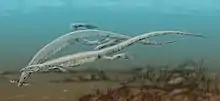Pleurosaurus
Pleurosaurus is an extinct genus of diapsid reptiles belonging to the group Sphenodontia, extinct relatives of the modern tuatara. Pleurosaurus fossils were discovered in the Solnhofen Limestone of Bavaria, Germany and Canjuers, France. It contains two species, P. goldfussi and P. ginsburgi.[1]

| Pleurosaurus | |
|---|---|
 | |
| P. goldfussi fossil specimen | |
| Scientific classification | |
| Kingdom: | Animalia |
| Phylum: | Chordata |
| Class: | Reptilia |
| Order: | Rhynchocephalia |
| Family: | †Pleurosauridae |
| Genus: | †Pleurosaurus Meyer, 1831 |
| Type species | |
| †Pleurosaurus goldfussi Meyer, 1831 | |
| Species | |
| |
Pleurosaurus is one of the few known aquatic sphenodontians. Its body was approximately 1.5 metres (4.9 ft) long,[2] and elongated for hydrodynamic streamlining, with comparatively short limbs and a powerful tail. The body was heavily modified from those of other rhynchocephalians, including an enlongated triangular skull. It swam via the use of poorly effiicient axial undulatory anguilliform locomotion (the movement of the body side to side) in shallow marine environments, and was probably piscivorous.[3] It had only small limbs, which probably did not aid in swimming, and nostrils placed far back on the head, close to the eyes.[4]

 P. goldfussi
P. goldfussi P. goldfussi
P. goldfussi P. ginsburgi
P. ginsburgi
References
- Dupret, V. (2004). The pleurosaurs: anatomy and phylogeny. Revue de Paléobiologie, 9: 61-80.
- Michael Benton, Vertebrate Paleontology 2009
- Klein, Nicole; Scheyer, Torsten M. (February 2017). "Microanatomy and life history in Palaeopleurosaurus (Rhynchocephalia: Pleurosauridae) from the Early Jurassic of Germany". The Science of Nature. 104 (1–2): 4. Bibcode:2017SciNa.104....4K. doi:10.1007/s00114-016-1427-3. ISSN 0028-1042. S2CID 27133670.
- Palmer, D., ed. (1999). The Marshall Illustrated Encyclopedia of Dinosaurs and Prehistoric Animals. London: Marshall Editions. p. 85. ISBN 1-84028-152-9.
